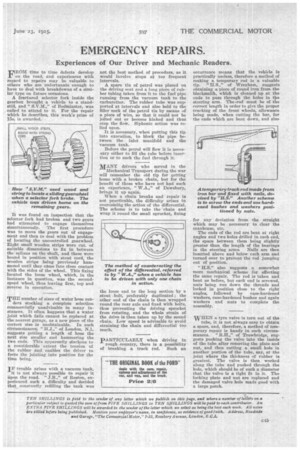EMERGENCY REPAIRS.
Page 29

If you've noticed an error in this article please click here to report it so we can fix it.
Experiences of Our Driver and Mechanic Readers,
FROM time to time defects develop on the road, and experiences with regard to repairs may be valuable to others who are unfortunate enough to have to deal with breakdowns of a similar type on future occasions.
A fractured selector fork inside the gearbox brought a vehicle to a standstill, and " S.V.M.," of Bedminster, was called to attend to it. For the repair which he describes, this week's prize of 15s. is awarded.
It was found on inspection that the selector fork had broken and two gears had attempted to engage themselves simultaneously. The first procedure was to move the gears out of engagement and then to deal with the problem of locating the uncontrolled gearwheel. Eight small wooden strips were cut, of suitable dimensions to fix in between the splines on the-shaft, and these were bound in position with stout cord, the wooden strips being previously hammered until they came into close contact with the sides of the wheel. This fixing located the loose wheel, which, in the instance in question, was the secondspeed wheel, thus leaving first, top and reverse in operation.
THE number of sizes of water hose ren ders stocking a complete selection commercially unadvisable in many instances. It often happens that a water joint which fails cannot be replaced at the nearest garage, as a new piece of the correct size is unobtainable. In such circumstances, " H.,T.," of London, Ni, suggests getting a length of hose the next size smaller and hammering the two ends. This apparently slackens to a considerable extent the tension of the rubber and enables the driver to force the jointing into position for the time being.
Ir trouble arises with a vacuum tank, it is not always possible to repair it upon the road. " J.B.," of Reston, experienced such a difficulty and decided that constantly refilling the tank was not the best method of procedure, as it would involve stops at too frequent intervals.
A spare tin of petrol was placed on the driving seat and a long piece of rubber tubing taken from it to the fuel pipe running from the vacuum tank to the carburetter. The rubber tube was supported at intervals and also held to the filler neck of the petrol tin by means of a piece of wire, so that it could not be jolted out or become kinked and thus stop the flow. Siphonie action was relied upon.
It is necessary, when putting this tip into execution, to block the pipe between the inlet manifold and the vacuum tank, Before the petrol will flow it is necessary either to fill the tube before insertion or to suck the fuel through it.
MANY drivers who served in the Mechanical Transport during the war will remember the old tip for getting home with a broken chain, but for the benefit of those who have not had such an experience, "WA.," of Dewsbury, brings it up again.
When a chain breaks and repair iS not practicable, the difficulty arises in overcoming the action of the differential. The scheme is to take the chain and wrap it round the small sprocket, fixing the loose end to the long section by a Stout bolt, preferably duplicated; the other end of the chain is then wrapped round the rear axle and fixed with bolts, thus preventing the driving sprocket from rotating, and the whole strain of the drive is then taken up by the sound chain. Low speed is advisable to avoid straining the chain and differential too much.
pARTICITLARLI when driving in rough country, there is a possibility of breaking a track rod. Such an
occurrence means that the vehicle is practically useless, therefore a method of mating a temporary rod is a valuable tip. "U.S.," of Wrexham, suggests obtaining a piece of round iron from the blacksmith, which is cleaned up at the ends to pass through the holes in the steering arm. The.rod must be of the correct length in order to give the proper tracking of the front wheels, allowance being made, when cutting the bar, for the ends which are bent down, and also for any deviation from the straight which may be necessary to clear the crankcase, etc.
The ends of the rod are bent at right angles and two holes drilled in each end, the space between them being slightly greater than the length of the bearings in the steering arms. Nails are then inserted above and below each arm and turned over to prevent the rod jumping out of position.
" H.S." also suggests a somewhat more mechanical scheme for effecting the same repair. The rod is taken and bent as before, but each end is screwed, nuts being run down the threads and locked in position close to the right angles, followed by case-hardened washers, case-hardened bushes and again washers and nuts to complete the assembly.
WHEN a tyre valve is torn out of the
tube, it is not always easy to obtain a spare, and, therefore, a method of temporary repair is handy in such circumstances. "R.H.," of Trowbridge, suggests pushing the valve into the inside of the tube after removing the plate and nut, and then cutting a small hole in another portion of the tube, say, at the joint where the thickness of rubber is greatest. The valve is then worked along the tube and pushed through the hole, which should be of such a diameter that the valve is a tight fit in it. The locking plate and nut are replaced and the damaged valve hole made good with a large patch.






























